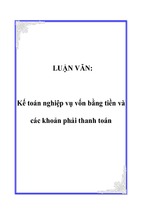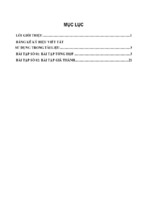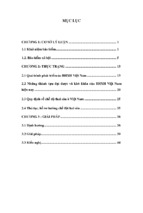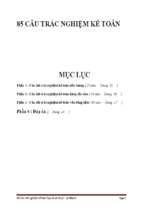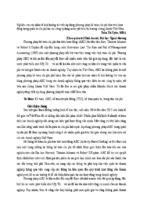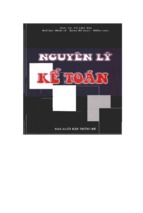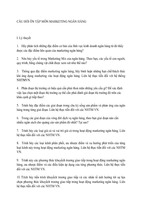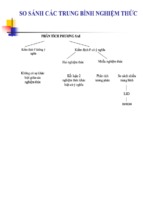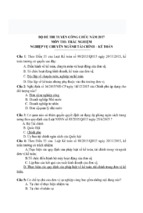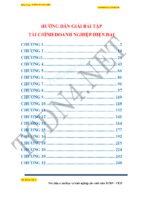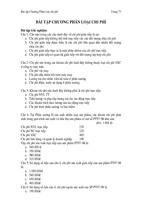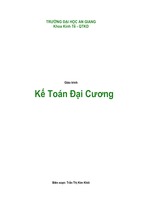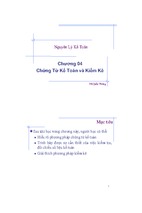See discussions, stats, and author profiles for this publication at:
https://www.researchgate.net/publication/229938166
An Empirical Analysis of the
Expenditure Budget in
Research and Development
Article in Contemporary Accounting Research · April 2010
DOI: 10.1111/j.1911-3846.1988.tb00685.x
CITATIONS
READS
49
69
2 authors:
Howard O. Rockness
Michael D. Shields
University of North Car…
Michigan State Univer…
8 PUBLICATIONS 285
69 PUBLICATIONS 3,903
CITATIONS
CITATIONS
SEE PROFILE
SEE PROFILE
All content following this page was uploaded by Michael D. Shields on 10 July 2015.
The user has requested enhancement of the downloaded file.
An empirical analysis of the expenditure
budget in research and development"^
HOWARD O. ROCKNESS University of North Carolina at Chapel Hill
MICHAEL D. SHIELDS San Diego State University
Abstract. This paper extends the prior empirical research that explains the perceived use
or importance of budget control or both, with organizational context and structure in
manufacturing organizations. In this paper, the perceived importance of expenditure budget
control in research and development (R&D) work groups is explained empirically by
organizational context (R&D work group size, source of R&D funding, and size of R&D
budget) and the management control system (steps in the control process, social control).
Data obtained from 76 R&D work groups in ten organizations support the five hypotheses.
Generally, there is an interaction between the steps in the control process and each of the
other independent variables on the perceived importance of expenditure budget control for
management control of the R&D work group.
Resume. Le present article s'inscrit dans le prolongement des travaux de recherche
empiriques precedents visant k expliquer l'utilisation pergue du controle budgetaire ou son
importance - sinon les deux - dans le contexte et la structure d'organisation des entreprises
manufacturieres. Dans cet article, l'importance du controle du budget des investissements
pergue par les groupes de travail en recherche et developpement (R & D) s'explique
concretement par le context organisationnel (la taille dti groupe de travail en R & D, la
source de financement des activites de R & D et l'importance des credits affectes a ces
activites) et par le systfeme de eontrole de gestion (etapes du processus de controle, controle
social). Les donn6es obtenues aupres de 76 groupes de travail en R & D dans dix
organisations viennent confirmer les einq hypotheses des auteurs. L'on releve, de fagon
generale, une interaction entre, d'une part, les etapes du processus de controle et chacune
des autres variables independantes et, d'autre part, l'importance pergue dti controle du
budget des investissements aux fins du controle de gestion du groupe de travail en R & D.
Introduction
Recent empirical research in managerial accounting explains variation in the
perceived use and importance of budget control in organizations (Bruns and
EDITOR'S NOTE: An earlier draft of this paper and the discussions by Jake Bimberg (see pp. 582-587)
and John Waterhouse (see pp. 588-594) were presented at the 1987 CAR Conference on Economic
and Behavioral Implications of Accounting Information and its Validation at McMaster University.
* The authors would like to thank Jake Bimberg, John Waterhouse and participants at the CAR
Conference for their many constructive comments on an earlier draft of this paper.
Contemporary Accounting Research Vol. 4 No. 2 pp. 568—581
Expenditure Budget in Research and Development
569
Figure 1 Mapping of organizations by knowledge of transformation process and measurability of
output
Measurability of output
Low
High
Knowedge of
input-output
transformation
process
High
R&D
Retailing
Administration
Manufacturing
Waterhouse (1975), Khandwalla (1972), Merchant (1981 and 1984)). This prior
research primarily examines operating budgets in manufacturing settings. The
present paper extends these prior studies by focusing on reseai'ch and development
(R&D) and by including new explanatory variables. R&D is an increasingly
important component of postindustrial economies. For example, the 844 U.S.
companies in the annual Business Week survey on R&D spent an average of 42
percent of pretax profits (or three percent of sales) on R&D in 1985. This was a ten
percent increase from 1985 {Business Week (1986)).
This research is framed using a contingency model proposed and tested by
Ouchi (1977, 1979). Ouchi's framework locates organizations and their subunits
on each of two dimensions: (1) knowledge of the process which transforms
resource inputs ioto outputs and (2) measurability of the output. The result, in
simplified form, is the Iwo-by-two matrix in Figure 1. A manufacturing
organization is typical of an organization in which the specific steps necessary to
transform resource inputs into outputs are well known and a measure of output is
usually available on a timely basis. Flexible budgets are well suited for control of
such organizatioos since they are based on fixed rules of performance, such as
staadard costs and variance analysis, and departures from standards are observable.
Such settings have been the focus of most of the accounting research on budgetary
control systems.
R&D is an important example of an organization that is at the opposite extreme
in Onchi's framework. In R&D, it is very difficult to obtain specific knowledge
about flie nature of the transformation process. It is also difficult to obtain
measures of output until long after the current activities have taken place. Flexible
budgets are not well suited for control in such settings, since they depend on both
precise knowledge of the transformation process and timely measurability of
outputs.
There axe also organizational units that fall between these two extremes. An
important example is retail selling organizations. They are characterized by low
knowledge of the transformation process, since it is difficult to specify exactly
what inputs are necessary, and how to transform those inputs in order to be
570 H.O. Rockness
M.D. Shields
successful at selling. Nevertheless, outputs (sales) are easily measurable in a
timely fashion. A different example is administration, e.g., insurance claims
processing. In this case, the transformation process is well known, but the output is
difficult to measure since it includes appropriate rejection of unjustified claims as
well as customer satisfaction.
The present study analyzes differences in the perceived importance of
expendittire budget control in R&D work groups that is due to the organizational
context (organizational size, expenditure budget size, source of funds) and the
management control system (importance of social control, steps in the control
process). This organizational setting is in the low knowledge/low measurability
ceil of Ouchi's framework (Figure 1). The present research uses Ouchi's
framework to provide a classification scheme of organizations and their subunits
and implications for control system design. It does not provide a test of variation in
the use of controls as a function of the two dimensions of the framework.
The first section of the paper reviews prior research on budget control from
which the research hypotheses are developed. The second section presents the
research method and develops the operational definitions and measurements of the
variables utilized in the study. In the third section the results are presented and the
final section contains a discussion of the results and directions for future research.
Prior research and hypotheses
Prior empirical research on budgets explains variation in the perceived importance
of budget control based on organizational context and stmcture. Context includes
both the organization's extemal environment (e.g., competition, uncertainty)
and intemal environment (e.g., size, technology). Structure is the pattem of
relationships among people which facilitate accomplishment of an organization's
goals, and includes decentralization, formalization and complexity (Gerwin
(1981, pp. 3-38); Hall (1982, pp. 49-126)). Bmns and Waterhouse (1975) found
that managers believe budget control is more important and is used more
frequently in larger, decentralized, more technologically sophisticated organizations in which there are formal and standard operating procedures. Merchant
(1981, 1984) found that managers perceive that budget control is both more
frequently used and more important in larger, more diverse, more functionally
differentiated, decentralized organizations which have automated technology.
Khandwalla (1972) reports that managers' perceived use of flexible budget control
is a positive function of competition that confronts their organization.
Prior research also examined the perceived use or importance of operating or
flexible budgets. In this research, the expenditure budget is analyzed, since prior
research indicates that it is the type of budget used in R&D (Anthony (1952, pp.
138-140); Anthony, Dearden and Bedford (1984, p. 207); Gambino and
Gartenberg (1979, pp. 7, 9); Lin and Vaserhelyi (1980)). In addition, the
expenditure budget is probably frequently used by other organizations or
organizational units in which there is a low level of knowledge of the input-output
transformation process and where outputs are difficult to measure on a timely
Expenditure Budget in Research and Development
571
basis. Examples include administration, legal and advertising. Expenditure
budget control is characterized by setting limits on the dollar size of activities, and
it serves to authorize the amount of funds that an organizational unit can spend to
support its activities. As such, expenditure budget control is primarily exercised
during planning to set the scope of activities and to authorize spending on those
activities. It also is used to monitor whether spending is within authorized
guidelines.
Management control system
Control process
The importance of expenditure budget control has been argued to vary with the
particulair step in the management control process (Anthony (1952, pp. 162-163,
183-184); Anthony, Dearden and Bedford (1984, p. 201); Gambino and
Gartenberg (1979, pp. 7, 9, 120)). Anthony, Dearden, and Bedford (1984, pp.
10-28) suggest that the four chronological steps in the control process for R&D are
planning, monitoring, evaluating, and rewarding. For example, an expenditure
budget is argued to be important as a control for planning because it details the flow
of resources which then guides management's action (Anthony, Dearden and
Bedford (1984, p. 201)). The expenditure budget is also important for monitoring
resource flows since it indicates how close those flows are to the authorized
spending level. The importance of expenditure budget control is likely to decrease
for steps in the control process that are more removed fi-om planning, such as
evaluatiHg and rewarding. One reason is that the expenditure budget, unlike a
flexible budget, generally is not ex post tailored to the actual level of activity.
Consequently, the expenditure budget is unlikely to be as important as a flexible
budget for evaluating and rewarding, since, like a static budget, it provides a rather
crude standard against which to compare actual spending (Anthony, Dearden and
Bedford (1984, p. 201)), There is no published literature which empirically tests
whether the perceived importance or use of (expenditure) budget control varies
with the steps in the control process.
HI: The perceived importance of expenditure budget control in R&D varies with the
chronological steps in the management coEtrol process. Specifically, the level of perceived importance decreases motiotonically from planning to monitoring, monitoring
to evaluating, and evaluating to rewarding.
Social control
Prior empirical research on budget control in organizations indicates that budget
control and social control are used with different organizational contexts and
structures (Bruns and Waterhouse (1975); Merchant (1981)). Social control can be
characterized by a rigorous personnel selection policy, hazing, direct supervision,
oral commuDication, continual peer interaction and professional association. The
importance of social control in R&D management has been argued for and
empirically demonstrated by prior research (Anthony (1952, pp. 193, 333-334);
572 H.O. Rockness
M.D. Shields
Gambino and Gartenberg (1979, pp. 106-107); Waterhouse and Tiessen (1978)).
Social control tends to be more prevalent in smaller, centralized, technologically
simple organizations (Bnins and Waterhouse (1975); Merchant (1981, 1984)). In
contrast, as reviewed earlier, budget control often is more prevalent in larger,
decentralized, technologically sophisticated organizations. Thus, these controls
are effective within different organizational contexts and structures. Although
both may be present, emphasis may be placed more strongly on one than the other.
This is hypothesized to hold despite the emphasis in R&D environments on
professional behavior. Thus, social control and expenditure budget control may be
substitutable because each is likely to be effective aod efficient in different
situations.
H2: There is a negative association between the perceived importance of social control and
the perceived importance of expenditure budget control.
Organizational context
Prior research has established that organizational context variables are associated
with variation in the perceived use or importance of budget controls (Bruns and
Waterhouse (1975); Khandwalla (1972); Merchant (1981, 1984)). Although none
of this research has focused on R&D, it has established the linkage between
organizational context and budget use at the organizational level and, by
implication, at unit levels within an organization. Hayes (1977) found contingency
relationships in performance measurement aod evaluation among organizational
subunits, specifically R&D, production and marketing. In this paper, the
hypotheses are developed based on the existing literature; however, the level of
analysis is explicitly identified as the R&D work group.
The organizational context variables included in this research are size of the
work group, source of R&D funds, budget size, measurability of the R&D output,
aod knowledge of the R&D technology. The latter two variables are included to
extract statistically any residual variance in the data that is due to variation in the
measurability of outputs and knowledge of transformation process (see Ouchi's
framework in Eigure 1). Thus, no hypotheses are offered for these two variables as
they serve the role of covariates in the hypothesis testing.
Work group size
The size of the work group is included since the organizational behavior literature
indicates that organizational size explains significant variation in formal organizational structures such as (expenditure) budget control (Eord and Slocum (1977);
Hall (1982, p. 56); Kimberly (1976)). As an organization gets larger, it typically
demands more formal stmctures to deal effectively with the increased complexity
of communication aod coordination (Bruos and Waterhouse (1975); Merchaot
(1981, 1984)). It is expected that these prior results apply to R&D work groups.
H3: There is a positive association between the perceived importance of expenditure
budget control and the R&D work group size.
Expenditure Budget in Research and Development
573
Source of R&D funds
Zimmerman (1976) provides empirical evidence that the level of uncertainty
conceming the source of funding, internal or external, for R&D affects
management's behavior with respect to the pattern of spending on R&D. Since
external sources are often more uncertain both as to timing of receipt and amount,
related e:ii;penditures tend to be discontinuous and thus are less likely to be efficient
and effective. Further, as Zimmerman argues, management has more incentive to
spend within the constraints of a budget when the source of funds is external,
relative to internal, because of the greater cost of having a negative relationship
with a funding source. This is likely to make the expenditure budget more
important for control when the work group receives external funding. The
expeaditiire budget also may be more important for control as more funds are
obtained externally, since the funding source often requires that it be used as a
meaes of monitoring the use of external funds.
H4: There is a positive association between the perceived importance of expendittire
budget control and the relative amount of funds received by the R&D work group
from sources external to the organization.
Size of budget
Anthony, Dearden and Bedford (1984, p. 200) argue that a principal way in which
maBagement controls a discretionary expense center such as R&D is by planning
the size or scope of jobs, and a common way to represent size or scope is the dollar
size of the (expenditure) budget. Consequently, the perceived importance to
managenaeot of a job or organizational unit, such as the R&D work group, may be
proxied by the dollar size of the expenditure budget. Similarly, an R&D manager
may believe that the expenditure budget is more important as the dollar size of the
badget increases because higher-level management allocates its attention to jobs or
units according to their perceived importance to the organization. More directly,
the expenditure budget may be more important as its size increases because of the
potential effect of the organizational unit on the firm's performance and
maoagement's desire for a common denominator, such as a budget, to control its
larger activities.
H5: There is a positive association between the perceived importance of expenditure
budget control and the dollar size of the R&D work group budget.
Hesearch method
Sample
The unit of analysis in this research was an organizational work group headed by
an R&D supervisor. Questionnaires were distributed by R&D executives in each
participating organization to a total of 113first-lineR&D supervisors. Seventy-six
(67 percent) usable questionnaires were returned by mail. Respondents returned
574 H.O. Rockness
M.D. Shields
their questionnaires directly rather than through the executive distributing the
questionnaires in the organization. As a measure of the respondents' interest, fifty
(66 percent) of them asked for a copy of the results.
The sample was drawn from ten organizations, of which eight organizations
were private, for-profit corporations, one was a federal govemment organization
and the other was a private, not-for-profit corporation. Five of the organizations
were located in a large R&D park in North Carolina, while the others were
dispersed throughout the U. S. These organizations conducted R&D in thefieldsof
electronics, communications, computers, environment, forest products, pharmaceuticals, toxicology, chemistry, containers, and research in the physical and
social sciences.
A five-page questionnaire was answered by each respondent. The first page
provided the context of the research and definitions of key terms. The rest of the
questionnaire was divided into four sections. The first requested information on
the respondent's work group and organization. The second section requested
information on the work group's budgeting and funding. The third set of questions
asked for information on work group tasks, while the fourth section elicited
information on work group controls.
It was not. possible to gather information for analysis of differences between
organizations, since the ten organizations required full anonymity as a condition of
participation. The R&D organizations in the sample were very sensitive on the
issue of confidentiality. The result was that there was no ethical way to
systematically assess the presence of a nonresponse bias. However, responses
were received promptly after distribution with no apparent pattem of differences in
responses. In addition, the response rate was very high (67 percent) for this type of
research and those requesting copies of results (66 percent) were distributed across
the ten organizations. Thus the potential for nonresponse bias is believed to be
small, although certainly a potential limitation on the generalizability of the
results. The requirement for anonymous responses also prevented a second request
to nonrespondents for completion of the questionnaire.
Measurement of variables
Management control system
Prior empirical research on budget and social control has operationalized and
measured controls as perceived use and/or importance for managing an organization (Brans and Waterhouse (1975); Khandwalla (1972); Merchant (1981,1984)).
In some studies, one scale was used to measure the overall use or importance of a
control in managing. In others, overall use or importance was measured on
subscales for one or more of the various steps in the management control process,
such as planning, monitoring, evaluating and rewarding, and then these subscales
were aggregated. In this research, the perceived importance of each control was
measured for each step in the management control process. The primary difference
in measurement between the present and prior research was the response format. In
Expenditure Budget in Research and Development
575
order to- provide a respondent with the opportunity to have a direct and systematic
response to the perceived importance of each control for each step of the
management control process, each response scale was in a cell of a twodimensional matrix. The column dimension included expenditure budget control
and social control. The row dimension was comprised of the four steps in the
management control process: planning, monitoring, evaluating and rewarding.
The importance ratings were on a five-point scale: no (0), little (1), moderate (2),
considerable (3), and extreme (4).
Organizational context
The size of the work group was measured as the sum of professional or technical
persons in the work group in each of the following fields: arts/humanities, biological sciences, engineering, medical, quantitative methods/computer science,
physical sciences, social sciences and other. While the "other" category was
included to ensure exhaustive measurement, it did not account for a significant
number of personnel.
The size of the expenditure budget was measured as the total number of dollars
received by the work group. Five intervals were used including: under $150,000;
$150,000 to $300,000; $301,000 to $600,000; $601,000 to $1, 200,000; and over
$l,200,i000. Intervals were used both to encourage responses from respondents
whose organizations might be reluctant to disclose the exact size of their budget
aod for ease of response. Source of R&D funds was measured by having
respondents enter the percentage of funds received from within their organization,
from governmental organizations and from other extemal sources. The sum of the
percentages entered in the latter two categories was used as the measure of
extemal source of funds.
The timelifless of the measurability of the output was captured by the questions:
"How soon is your work group's output measurable in numbers?" (anchored by (1)
"Immediately measurable" and (9) "Never measurable") and "To what extent is
your work group's output measurable in numbers?" (anchored by (1) "Not
measurable in numbers" and (9) "Completely measurable in numbers"). Knowledge of the R&D input-output transformation process was measured as: "How
much do you know about the research and/or development transformation process
your work group uses to yield a specific output?" (anchored by (1) "No
knowledge" and (9) "Complete knowledge") and as "To what extent do you
know that the set of inputs your work group uses will result in a specific output?"
(anchored by (1) "No knowledge of relationship between input and output" and (9)
"Complete knowledge of relationship between input and output").
ResHlts
Descriptive statistics
Means and standard deviations of the dependent and independent variables are
preseoted in Tables 1 and 2. Inspection of the data indicated that the budget size
576
H.O. Rockness
M.D. Shields
TABLE 1
Descriptive statistics
Variable
Mean
Std, dev.
Budget - Planning
Budget - Monitoring
Budget - Evaluating
Budget - Rewarding
Social - Planning
Social - Monitoring
Social - Evaluating
Social ~ Rewarding
Work group size
External source funds*
Size of R&D budget*
2.96
2.66
2,28
2,11
2,25
2,29
2,26
2.36
18.95
0,20
0,50
1,07
1,02
1.04
1,15
1,21
1,24
1.25
1.21
23,70
0.40
0.50
74
74
74
73
73
73
73
74
73
76
75
* 0-1 dummy variable.
TABLE 2
Perceived importance of expenditure budget control
Control
process
Source of
funds
Size of R&D
budget
Social control
Work group
size
Low
High
Small
Large
Int,
Ext.
Small
Large
Planning
X
3,24
0,76
2,67
1.29
2,91
1,13
2,97
1,06
2,91
1,16
3,20
0,68
2,89
1,16
3,06
1,01
Monitoring
X
2,73
0,84
2,61
1,25
2,42
1.06
2,79
0,98
2,56
1,03
3,07
1,03
2,49
1,01
2,82
1,06
Evaluating
X
2.49
0,93
2,12
1,14
1.91
1,07
2.59
0,86
2,22
1,03
2,67
1.05
1,83
0,98
2,76
0,85
1.92
1.09
2.24
1,20
1,76
1,00
2,32
1,25
1,98
1.03
2,40
1,50
2,06
1,11
2,06
1,20
s
Rewarding
X
s
Legend: x = mean; s = standard deviation.
and external source of R&D funds variables were significantly skewed. Consequently, they were rescaled to be 0-1 dummy variables. Zero represented either
small budget size or internal source(s) of funds, while one represented either large
budget size or external source(s) of funds. Budget size was split at the median,
with the result that small budget size was defined as a budget of less than or equal to
$1,200,000. The source of funds variable was bimodal, since work groups
received either almost all (> 97 percent) or none (^ 2 percent) of their funds from
internal sources. Internal sourcing of funds was defined as greater than or equal to
97 percent of funds being received from internal sources and external sourcing of
funds was defined as greater than or equal to 98 percent of funds being received
from external sources. This classification scheme was intended to separate
categorically those work groups which had significant external funds from those
which did not.
Expenditure Budget io Research and Development
577
Hypothesis testing
HI was tested by a four-level one-way repeated measure analysis of covariaoce
(ANCOVA). The dependent variable was budget importance, the four levels were
the steps in the control process while the covariates were the four measurability of
output and knowledge of R&D transformation process variables. The other four
hypotheses were each tested by a two by four ANCOVA. The dependent variable,
again, was budget importance. The four levels of the repeated measures variable
were the steps in the control process with the two levels of the between-subjects
variable dependent on the specific hypothesis (low or high social control, small or
large work group size, internal or external source of funds, small or large budget
size). In testing H2, social control was dichotomized by splitting it at its median;
the result was that low social control was less than nine and high social control was
greater than nine. In testing H3, work group size was dichotomized by splitting it
at its raedian; the result was that small size was less than 11 professional employees
and large size was greater than or equal to 11 professional employees. The
covariates were the four measurability of output and knowledge of transformation
process variables. None of the covariates in aoy of the five ANCOVAs was
statistically significant at conventional levels of significance.
Management control system
Control process
Ul predicted that the perceived importance of the expenditure budget for
management controi io R&D moootonically decreases across planoiog, monitoring, evjiluating and rewarding. The hypothesis was tested using a one-way
repeated measures ANCOVA with Tukey contrast analysis. The perceived
importajice of expenditure budget control was significaotly differeot as expected
across steps io the control process (F = 14.1, p < 0.0001). (This cootrol process
variable was also highly significant (p < 0.001) in each of the ANCOVAs to be
reported for the tests of H2-H5.) The means were 2.96 for planning, 2.66 for
monitoring, 2.28 for evaluating and 2.11 for rewarding (see Table 1). The contrast
analysis indicated that five of the six pairwise contrasts were sigoificaot (p <
0.05), the exception was the difference between evaluating aod rewarding. These
results supported HI.
Support for E l raised the potential for interaction effects between steps io the
control process and each of the other blocking variables. For example, H2
suggested that there would be a negative association between the perceived
importance of social control and the perceived importance of budget control.
Results for HI suggested that the degree of association between the importance of
budget control and social control may be contingent on the particular step in the
contj-ol process. Statistically, this outcome would be observed if there was a
significant interactioo effect between steps in the control process and the
importance of social cootrol. Thus, interaction effects are examined in the results
which follow.
578 H.O. Rockness
M.D. Shields
Social control
The mean of social control was invariant to the step in the control process (see
Table 1): planning, 2.25; monitoring, 2.29; evaluating, 2.26; rewarding, 2.36. H2
predicted a negative association between the perceived importance of expenditure
budget control and social control. Thus, we expected to find that budget control
was more (less) important when social control was of low (high) importance.
Inspection of Table 2 found this result for three of the four control steps; the
exception was rewarding. Across the steps in the control process, the differences
in means were 0.57 for planning, 0.12 for monitoring, 0.37 for evaluating, and
-0.32 for rewarding. The importance of expenditure budget control varied
between levels of social control almost five times (0.57/0.12) as much for
planning as for monitoring. This indicated that, for monitoring, the expenditure
budget had a fairly constant level of importance regardless of the importance of
social control. Apparently, work groups perceived the expenditure budget always
to be important for monitoring. For rewarding, the expenditure budget was more
important when social control had high vs. low importance (2.24 vs. 1.92).
Consequently, since the difference in the importance of budget control varied
between levels of social control as well as among steps in the control process, there
was a significant interaction (F = 3.36, p = 0.02) between steps in the control
process and social control, but not a significant main effect for social control (F =
1.19, p = 0.28). The nonsignificant main effect for social control was due to the
expenditure budget being less important for rewarding when the level of
importance for social control was high vs. low. The effect was to reduce the
marginal difference in means between levels of social control. In this case, the
interaction effect provides the test of the hypothesis. Thus, these results supported
H2.
Organizational context
Work group size
H3 predicted a positive association between expenditure budget control and work
group size. For all four steps in the control process, the importance of budget
control was higher when the work group was larger (see Table 2): 0.06 higher for
planning; 0.37 for monitoring; 0.68 for evaluating; and 0.56 for rewarding. Except
for planning, budget control was more important as work group size increased.
The budget was uniformly of relatively high importance for planning. The
inferential result was a significant (F = 6.07, p < 0.02) main effect for work group
size and a marginally significant (F = 2.22, p = 0.095) interaction between steps
in the control process and work groups size. Overall, these results supported H3.
Source of R&D funds
H4 predicted that budget control is more important when funds are externally
sourced. For all four steps in the control process, the expenditure budget was more
important when funds were from external compared with internal sources (see
Expenditure Budget in Research and Development
579
Table 2). The differences in means due to sourcing for the four steps were fairly
uniform ranging from 0.29 for planning to 0.51 for monitoring. There was a
significant main effect due to source of funds {F = 3.50, p = 0.06) but not a
significant interaction between source of funds and steps in the control process {F
= 0.17, p = 0.92). Overall, these results provided support for H4.
Size of R&D budget
H5 predicted that the importance of budget control increases as the size of the
budget increases. For each of the control steps, the budget was more important
when its size was larger; the increase in importance was 0.17 forplanning; 0.33 for
monitoring: 0.93 for evaluating; and 0.002 for rewarding. Since the difference in
means varied with the steps in the control process, there was a significant
interaction between control process and budget size {F = 5.59, p = 0.002). The
budget size main effect was also significant (^F = 4.41, p = 0.04). These results
supported H5.
' ,.,
Discussion and conclusions
The results and following conclusions should be interpreted within the caveats
associated with exploratory, cross-sectional field survey research where data have
been collected from a limited number of organizations. A primary result of the
tests of liie hypotheses is that, in general, the importance of expenditure budget
control was explained statistically by the management control system - steps in
control process (HI) and the importance of social control (H2) - and organizational context variables - work group size (H3), source of R&D funds (H4), and
budget size (H5). In addition, there were interactions between the steps in the
coBtroJ process and each of social control, work group size and budget size, but not
with source of funding.
The results of this study both support and extend the prior research on budget
control. These results support prior research by demonstrating a contingency
relationship between budget control and organizational context. The importance
of expenditure budget control was found to vary with three context variables, work
group size, budget size and source of R&D funds.
The results of this study also extend the prior research in three ways. First, a new
budget a ad a new functional area were examined. This extension is valuable given
the increasing importance of R&D in society. As society shifts away from
organizations in which flexible budgets are appropriate toward organizations in the
low/low cell of Ouchi's fraroework (see Figure 1), additional research on
organizational units, such as administration, services, retailing and R&D, is
valuable in understanding budget control in contemporary organizations.
Second, the results show an interaction between steps in the control process and
each of social control, work group size and budget size. Future research should
explore the extent to which variation in the importance of the budget across steps in
the control process is unique to the expenditure budget. The control process may
have beeo important because the expenditure budget is not ex post tailored to
580 H.O. Rockness
M.D. Shields
actual activity and thus it is more important for early steps in the process. In
contrast, a flexible budget may be of universal importance, or even of increased
importance, through the steps in the control process, because it is ex post tailored
to a specific level of activity.
Third, our results as well as those of Bruns and Waterhouse (1975) and
Merchant (1981) indicate that budget control and social control are used in
different organizational settings and may be partially substitutable. Future
research should examine further the contingent nature of both the mix and use of
altemative controls.
Future research could examine both additional variables and address the
measurement issues inherent in both this and the prior budget research. The
additional variables might include strategy, incentives, incentive risk sharing
trade-offs, short run vs. long run balance, peformance, control by reputation and
culture, and intemal competition for funds. The breadth and exploratory nature of
this research precluded formal attempts to address measurement issues here. This
research relied on measurements which had been used in prior research. The
generaUzability of the results is limited to the extent that there is measurement
error. Future research should address more carefully the issues of validity and
reliability of the measurement of the variables. Such future extensions are a
necessary part of developing a more complete understanding of budget control.
References
Anthony, R., Management Controls in Industrial Research Organizations (Harvard
University Press: Boston, Mass. 1952).
- , J. Dearden and N. Bedford, Management Control Systems (Irwin: Homewood,
Illinois 1984).
Bruns, W. and J. Waterhouse, "Budgetary Control and Organizational Structure," Journal
of Accounting Research (Autumn 1975) pp. 177-203.
Business Week, "R&D Scoreboard" (June 23, 1986) pp. 134-56.
Ford, J. and J. Slocum, "Size, Technology, Environment and the Stmcture of Organizations," Academy of Management Review (October 1977) pp. 561-75.
Gambino, A. and M. Gartenberg, Industrial R&D Management (National Association of
Accountants: New York, New York 1979).
Gerwin, D., "Relationships Between Structure and Technology," in: P. Nystrom and W.
Starbuck (eds.). Handbook of Organization Design (Oxford University Press: Oxford,
England 1981) pp. 3-38.
Hall, R., Organizations: Structure and Process, Third Edition (Prentice-Hall: Englewood
Cliffs, New Jersey 1982).
Hayes, D., "The Contingency Theory of Managerial Accounting," The Accounting Review
(January 1977) pp. 22-39.
Khandwalla, P., "The Effects of Different Types of Competition on the Use of Management Controls," Journal of Accounting Research (Autumn 1972) pp. 275-85.
Kimberly, J., "Organizational Size and the Structuralist Perspective: A Review, Critique
and Proposal," Administrative Science Quarterly (December 1976) pp. 571-97.
Lin, T. and M. A. Vasarhelyi, "Accounting and Financial Control for R&D Expenditures,"
TIMS Studies in the Management Sciences (Number 15 1980) pp. 199-213.
Merchant, K., "The Design of the Corporate Budgeting System: Influences on Managerial
Behavior and Performance," The Accounting Review (October 1981) pp. 813-29.
Expenditure Budget in Research and Development 581
, "Influences on Departmental Budgeting: An Empirical Examination of a Contingency Model," Accounting, Organizations and Society (June 1984) pp, 291-307.
Ouchi, W., "The Relationship Between Organizational Structure and Organizatiooal
Control," Adminstrative Science Quarterly (March 1977) pp. 95-113.
, "A Conceptual Framework for the Design of Organizational Control Mechanisms," Management Science (September 1979) pp. 833-47,
Waterhouse, J. and P. Tiessen, "A Contingency Framework for Management Accounting
Systems Research," Accounting, Organizations and Society (August 1978) pp.
65-76.
Zimmennan, G., "Budget Uncertainty and the Allocation Decision in a Nonprofit
Organization," Journal of Accounting Research (Autumo 1976) pp. 301-19,
- Xem thêm -

